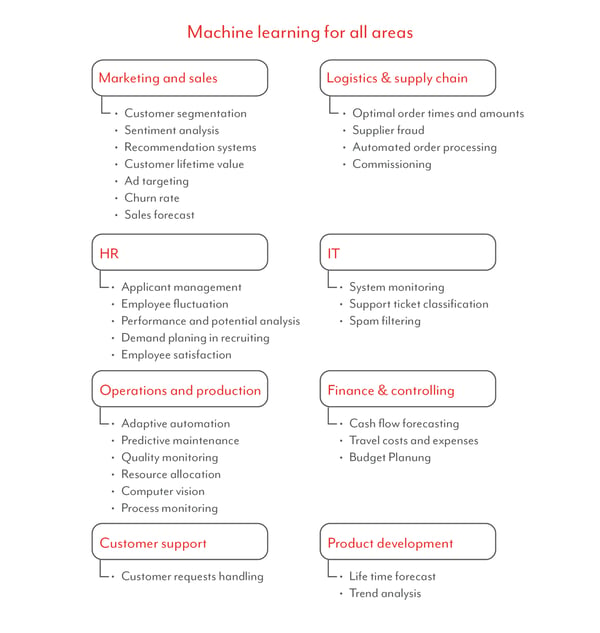Machine Learning (ML) will continue to be a popular answer to current business challenges in 2021. While on the one hand the business world is becoming more and more complex and the competitive pressure on sales and procurement markets is increasing every day, on the other hand the starting position for successful machine learning applications is getting better and better.
Never before was such a qualitative, extensive amount of data available. Data processing also benefits enormously from numerous, mature infrastructure solutions and the increased computing power. It is not surprising why Machine Learning as a part of Artificial Intelligence (AI) is used to face the rapid changes with a top-notch reaction speed.
In this article you will get to know some practical machine learning use cases that describe how machine learning can be used in your company. Be inspired by our application examples and take along valuable tips for the introduction to machine learning.
Capabilities of Machine Learning
In organizations, decisions are often based on Key Performance Indicators (KPI). In line with this, machine learning has its own KPIs, so-called features. They serve as input for the computation. With their assistance, the model can learn complex dependencies and interactions and generate a specific output.
.png?width=600&name=1.%20Anwendungsgebiet%20ML%20(en).png)
What can this output look like? On the one hand, the similarity between data sets can be determined and they can be assigned to a group. Here we distinguish between groups defined in advance (classification) and the recognition of patterns (clustering). If the information base is to be used in order to determine a target value, this is referred to as regression. Especially interesting is data over time, where trends can be identified and critical events can be highlighted.
- Classification of data (e.g. Person healthy or sick)
- Making forecasts (e.g. Sales Forecast)
- Detecting patterns (e.g. Customer cluster A, B, C)
- Recognition of trends, critical events (e.g. Machine downtime)
With the right data management and clever workflow solutions, the machine learning processes run completely automatically in the end. Important information from invoices from different suppliers can be transferred to the database without manual intervention, or the most relevant content can be immediately identified and displayed in the company's own knowledge management system.
Exciting ideas for application
The broad spectrum of possibilities of machine learning opens up numerous perspectives in the most diverse departments of a company. The mind map shows only a small selection of these possibilities. In the following, we will briefly introduce you to the different application cases of the project ideas.
- Cash flow forecasts
- Fraud detection for customers and suppliers
- Employee fluctuation
- Customer segmentation
- Predictive Maintenance

By using Machine Learning for your cash flow forecasting, the accuracy of forecasting available capital can be increased by a factor of several times. Forecasts can be executed on different time periods and levels (product or global). The amazing thing about it: Usually, the extensive business data you need is already available within your databases in order to get started.
Do you want to protect yourself against fraud in the customer and supplier environment? Of course you need a holistic solution that goes beyond your IT systems. Machine Learning can still provide valuable support. Thousands of characteristics can be analyzed in real time and send out an alert for suspicious cases or trigger automated countermeasures.
Boost your business with Artifical Intelligence and Machine Learning
In addition to the reliable detection of real fraud, the false positive rate is another quality criterion when using machine learning models. This indicates the proportion of suspicious cases that have not been confirmed as fraud after thorough examination and have therefore been incorrectly classified. This rate should be kept as low as possible (without limiting reliable detection) in order to achieve an efficient and economical system. To achieve this, it is often necessary to fine-tune the ML models, balancing the risk of undetected fraud against the cost of the manual validation.
Machine learning can also be used to better assess employee fluctuation. Early signs can be detected and help you make better personnel decisions and estimate the need for recruitment. To ensure that data collection does not end in the monitoring of your employees, only experts should be consulted, especially for projects with intensive data protection requirements.
Get to know your customers better and use Machine Learning for customer segmentation. In addition to basic characteristics such as industry, company size, location, it is also possible to integrate new, increasingly complex characteristics, for example, relating to the intensity and type of customer contact. The segmentation enables a more targeted approach and opens up new ways of product personalization.
Machine Learning is also versatile in production. Machine data, data from the production management system or shop floor data collection can be used effectively to save costs. In the area of maintenance, machine data can be analyzed (predictive maintenance) in order to optimize maintenance cycles or to indicate an impending breakdown. Appropriate service can prevent consequential damage and a long downtime and thus reduce production costs.
The many exciting fields of application can be conquered and expanded with your own projects: the possibilities are almost unlimited. In our experience, the number of use cases accelerates very quickly, once the advantages and capabilities of Machine Learning are tangible. The first step is possible in every department by improving planning processes depending on peripheral conditions or the targeted recognition and classification of events, situations or persons. The results are only a project start away!
4 tips for the optimal start
Finally, we would like to give you helpful tips for the entry into machine learning projects:
- Use Case first
Define a use case or a concrete question to be worked on in the project and make sure that access to the relevant data is possible. Assemble a team of experts with process knowledge, data know-how and analytical skills. - Gain experience with smaller projects
In contrast to conventional IT projects, ML projects require different hardware, software and other know-how. Therefore, it is better to start with the improvement of a process step instead of getting lost in the complexity of a costly large-scale project. - Have realistic expectations
The impressive end result of a machine learning project does not happen overnight. You should budget sufficient time (at least 3 months) and set the goal of improving existing benchmarks. - The right know-how simplifies the start
While the novel knowledge is being built up within the company, support with expert knowledge from outside can enrich the project with important practical experience.
Are you ready for your (next) machine learning project? We are happy to support you with the implementation or optimization of AI projects. In our whitepaper "How to advance your business through Artificial Intelligence and Machine Learning" we present further use cases as well as machine learning and data science projects from scratch.
This article was published as part of the blog parade #TheAIFactory of the blog Ingenieurversteher.de
Introduction to Machine Learning

/Logo%202023%20final%20dunkelgrau.png?width=221&height=97&name=Logo%202023%20final%20dunkelgrau.png)
























